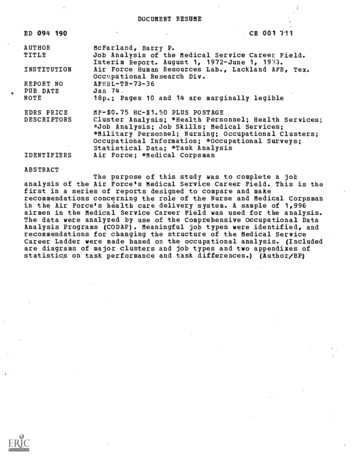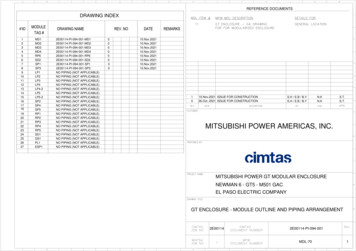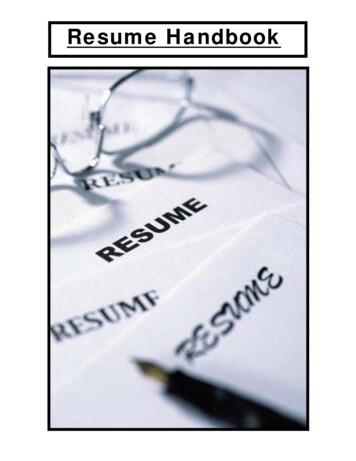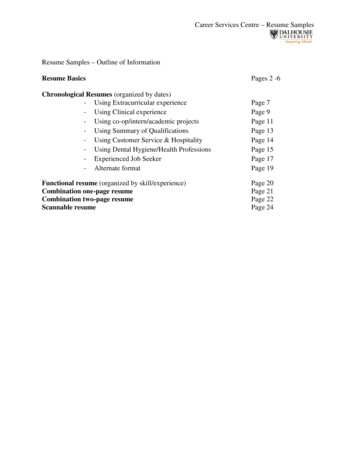
Transcription
DOCUMENT RESUMEED 094 190AUTHORTITLEINSTITUTIONREPORT NOPUB DATENOTEEDRS PRICEDESCRIPTORSIDENTIFIERSCE 001 711McFarland, Barry P.Job Analysis of the Medical Service Career Field.Interim Report. August 1, 1972-June 1, 19V3.Air Force Human Resources Lab., Lackland AFB, Tex.Occupational Research Div.AFEVL-TR-73-36Jan 74.18p.; Pages 10 and 14 are marginally legibleMF- 0.75 HC- 1.50 PLUS POSTAGECluster Analysis; *Health Personnel; Health Services;*Job Analysis; Job Skills; Medical Services;*Military Personnel; Nursing; Occupational Clusters;Occupational Information; *Occupational Surveys;Statistical Data; *Task AnalysisAir Force; *Medical CorpsmanABSTRACTThe purpose of this study was to complete a jobanalysis of the Air Force's Medical Service Career Field. This is thefirst in a series of reports designed to compare and makerecommendations concerning the role of the Nurse and Medical Corpsmanin the Air Force's health care delivery system. A sample of 1,996airmen in the Medical Service Career Field was used for the analysis.The data were analyzed by use of the Comprehensive Occupational DataAnalysis Programs (CODAP). Meaningful job types were identified, andrecommendations for changing the structure of the Medical ServiceCareer Ladder were made based on the occupational analysis. (Includedare diagrams of major clusters and job types and two appendixes ofstatistics on task performance and task differences.) (Author/BP)
BEST COPY AVAILABLEAFHR TR-73.36AIR FORCEThlJOB ANALYSIS OF THE MEDICAL SERVICE CAREER FIELDHUSI'MAByBarry P. McFarland, 1st Lt, USAFNOCCUPATIONAL RESEARCH DIVISIONLack land Air Force Base, Texas 78236U.S. DEPARTMENT OF HEALTH,EDUCATION 8 WELFARENATIONAL INSTITUTE OFEDUCATIONTHIS DOCUMENT HAS BEEN REPRODLICED EXACTLY AS RECEIVED FROMTHE PERSON OR ORGANIZATION ORIGINATING IT POINTS OF VIEW OR OPINIONSJanuary 1974URSTATED 00 NOT NECESSARILY REPRESENT OFFICIAL NATIONAL INSTITUTE OFEDUCATION POSITION OR POLICYApproved for public release; distribution unlimited.CESLABORATORY0OAIR FORCE SYSTEMS COMMANDBROOKS AIR FORCE BASE,TEXAS 78235
NOTICEWhen US Government drawings, specifications. or other data are usedfor any purpose other than a definitely related Governmentprocurement operation, the Government thereby incurs noresponsibility nor any obligation whatsoever, and the fact that theGovernment may have formulated, furnished, or in any way suppliedthe said drawings, specifications, or other data is not to be regarded byimplication or otherwise, as in any manner licensing the holder or anyother person or corporation, or conveying any rights or permission tomanufacture, use, or sell any patented invention that may in any waybe related thereto.This interim report was submitted by Occupational Research Division,Air Force Human Resources Laboratory, Lack land Air Force Base,Texas 78236, under project 7734, with the Hq, Air Force HumanResources Laboratory (AFSC), Brooks Air Force Base, Texas 78235.This report has been reviewed and cleared for open publication and/orpublic release by the appropriate Office of Information (01) inaccordance with AFR 190-17 and DoDD 5230.9. There is no objectionto unlimited distribution of this report to the public at large, or byDDC to the National Technical Information Service (NTIS).This technical report has been reviewed and approved.RAYMOND E. CHRISTAL, ChiefOccupational Research DivisionApproved for publication.HAROLD E. FISCHER, Colonel, USAFCo mmander
UnclassifiedSECURITY CLASSIFICATION OF THIS PAGE (When Data Entered)READ INSTRUCTIONSBEFORE COMPLETING FORMREPORT DOCUMENTATION PAGE2. GOVT ACCESSION NO, 3.1. REPORT NUMBERRECIPIENT'S CATALOG NUMBERAFHRL-TR-73.365. TYPE OF REPORT 8 PERIOD COVERED4. TITLE (and Subtitle)JOB ANALYSIS OF THE MEDICAL SERVICE CAREER FIELDInterim 1 Aug 72 - 1 Jun 736. PERFORMING ORG. REPORT NUMBER8. CONTRACT OR GRANT NUMBER(a)7. AUTHOR(a)Barry P. McFarland, 1st Lt, USAF10. PROGRAM ELEMENT, PROJECT, TASKAREA 8 WORK UNIT NUMBERS9. PERFORMING ORGANIZATION NAME AND ADDRESSOccupational Research DivisionAir Force Human Resources Laboratory (AFSC)Lackland AFB, Texas 782367734011512. REPORT DATEII. CONTROLLING OFFICE NAME AND ADDRESSJanuary 1974Hq Air Force Human Resources LaboratoryBrooks Air Force Base, Texas 7823513. NUMBER OF PAGES1814. MONITORING AGENCY NAME & ADDRESS(lf different from Controlling Office)IS. SECURITY CLASS. (of thin report)UnclassifiedI5a. DECLASSIFICATION /DOWNGRADINGSCHEDULE16. DISTRIBUTION STATEMENT (of this Report)Approved for public release; distribution unlimited.17DISTRIBUTION STATEMENT (of the abstract entered In Block 20, if different from Report)18. SUPPLEMENTARY NOTESThis research was carried out under Project 7734, Development of Methods for Describing, Evaluating andStructuring Air Force Occupations; Task 773401, Development of Methods for Collecting, Analyzing and ReportingInformation Describing Air Force Specialties.(Continued on reverse side)19. KEY WORDS (Continue on reverse side if necessary and identify by block number)cluster analysisCODAPhierarchical groupingMedical Service Career Fieldoccupational analysisjob typesmedical personnel20. ABSTRACT (Continue on reverse side If necessary and Identify by block number)The purpose of this study was to complete a job analysis of the Air Force's Medical service Career Field. This isthe first in a series of reports designed to compare and make recommendations concerning the role of the Nurse andMedical Corpsman in the Air Force's health care delivery system. A sample of 1,996 airmen in the Medical ServiceCareer Field (AFSC 902X0, 90292) was used for the analysis. The data were analyzed by use of the ComprehensiveOccupational Data Analysis Programs (CODAP). Meaningful job types were identified and recommendations forchanging the structure of the Medical Service Career Ladder were made based on the occupational analysis.FORMDD I JAN 73 1473EDITION OF 1 NOV 65 IS OBSOLETEUnclassifiedSECURITY CLASSIFICATION OF THIS PAGE (When Data Entered)
UnclassifiedSECURITY CLASSIFICATION OF THIS PAGEOMen Data Entered)18. Supplementary Notes (continued)The job inventory for the Medical Service Career Field was constnicted and administered by Lifson, Wilson,Ferguson, and Winick, Inc., under contract F41609-70-C.0043 monitored by the Air Force Human ResourcesLaboratory's Occupational Research Division (7734-01-12).Consolidated descriptions of job type groups, together with other pertinent printout data, are available toqualified requesters on a loan basis from the Air Force Human Resources Laboratory's Occupational ResearchDivision/PEOA, Lackland AFB, Texas 78236.UnclassifiedSECURITY CLASSIFICATION OF 'THIS PAGE(When Dora Entered)
BEST COPY AVAILABLETABLE OF CONTENTSPageIntroductionI.3Definition of Utilization FieldDefinition of Occupational AnalysisThe Job InventoryII.III.333Identification of Job Types4Results4Emergency Services - Outpatient GRP 123Ward Services Cluster - Inpatient GRP 268OB Ward-Inpatient - GRP 64Administrative Services Cluster Inpatient GRP 55Air Evacuation - GRP 151Other Patient Services - GRP 21Central Sterile Supply - GRP 13DiscussionIV.45566677References11Appendix A. Primary Tasks Performed by Major Clusters13Appendix B. Task Difference Description Between Groups 132 and 26815LIST OF ILLUSTRATIONSFigurePageDiagram of Major Clusters and Job Types19LIST OF TABLESTable,1Page"'Distribution of Sample Across Major Air Commands82Distribution of Duty AFSC's For Total Sample83Grade Distribution of Total Sample84Task Description for GRP 1-Total Sample105Descriptive Task Data for Major Clusters and Subclusters116Descriptive Background Data for Major Clusters and Subclusters111
BEST COPY AVAILABLEJOB ANALYSIS OF THE MEDICAL SERVICE CAREER FIELDI. INTRODUCTIONThisstudyispartofaincumbent supplies identification and backgrounddata and checks those tasks which are part of hispresent job. He then rates the tasks he checked ona 7-point scale, indicating the relative amount ofcomprehensiveexperimental program developed in cooperationwith the Nursing Resources Study Group appointed by the Air Force Surgeon General. TheNursing Reiources Study Group was interested inthe survey as a source of quantitative, AirForce-wide information on Air Force nurse andmedical service specialties for use in determiningcurrent and future Air Force nurse requirements.This report is the first of a series of reportstime spent on each task compared to all othertasks performed. The ratings range from 1 (verymuch below average) to 7 (very much aboveaverage) with 4 being a mid-point (about average).The techniques for conducting occupationalsurveys and analysis are reported in a series ofto analyze the commonality of tasksperformed by Air Force nursing and medicaldesignedresearch reports dating back to 1958. Past researchand continuing experience with survey dataservice personnel. The purpose of this report wasto describe the occupational analysis of a samplederived from the job task inventory indicate thatthis technique produces highly reliable informa-of 1,996 airmen in the medical Service CareerField and to place their jobs into meaningful jobtypes. Reports describing the job analysis oftion about existing Air Force jobs.Air Force occupational surveys are authorizedunder AFM 35-2, Occupational Analysis, and arepart of the Air Force Personnel Testing Program.The computer analysis system, Compreb.:nsiveOccupational Data Analysis Programs (CODAP),developed for use in the analysis of occupationalsurvey data consists of almost 50,000 programinstructions and is fully documented only innursing personnel are currently in various stages ofcompletion. The final report of this series willconsist of a comprehensive comparison of tasksperformed by Air Force nursing and medicalpersonnel with emphasis on possiblerecommendations for management in regard todelineation of duties and responsibilities withinthe current structure of the Air Force health careservicetechnical systems manuals.delivery systems.The Job InventoryDefinition of Utilization FieldThe job inventory was constructed using thegeneral procedures described by Morsh and ArcherThe Medical Service Utilization Field includesthe Medical Service Specialist, AFSC 90230/50,(1967). The inventory consisted of 600 taskstatements grouped under 11 duty headings. Ofthe 600 tasks, 575 tasks were identical orequivalent to task statements used in the NurseUtilizationFieldAFPTJobInventory,80-97XX-011. The other 25 tasks were unique tothe Medical Service Technician, AFSC 90270, andthe Medical Service Superintendent, AFSC 90292.According to AFM 39-1, the Medical Service"Performs technical 'nursing dutiesinvolved in the care and treatment of patients;Specialistthe Medical Service Utilization Field and notassists with patient movements by air evacuationand ambulance; and assists with nonflying physicalexaminations." The 7- and 9-skill level descriptionsrequire administrative and supervisory experienceand assign greater responsibility for independentduty. The Medical Service Specialist is required tointeract and coordinate with patients, physicians,performed by nurses. The biographical information included in the survey was kept as similar aspossible to the Nurse Utilization Field Inventory.The job inventory was administered in accordance with AFM 35-2 at each Air Force base andapproximately 2,800 completed survey bookletswere returned for analysis. From the 2,800returns, 1,996 cases were randomly selected forinclusion in the job-type analysis. The 1,996sample size was used because of existing samplesize restrictions in the present computing capa-and nurses to provide a comprehensive, highquality patient care service.Definition of Occupational AnalysisThe Air Force method of occupational analysismakes use of Air Force-wide job surveys for thecollection of quantitative data directly from jobbility of the CODAP system on the IBM 7040computer. Distributions of cases selected byCommand, Duty AFSC, and Grade are included inTables 1, 2, and 3.incumbents who describe their job within thespecialty area. In completing the job survey, each3
II. IDENTIFICATION OF JOB TYPESAs a first step in the analysis, the computerjob types and the identification of the primaryeach individual's relative time-spenttasks performed by each job type, are included inAppendix A and B.convertsresponses (1-7 scale) to percent time ratings. Toobtain the percent time ratings, all of anincumbent's time-spent ratings are summed andthe total is assumed to represent 100 percent ofhis time spent on the job. Each rating is divided byIII. RESULTSthe total and the quotient multiplied by 100 togive a percent time spent estimate on each task,For the purpose of organizing jobs into similarunits of work, an automated job-clusteringcomputer program was used. This hierarchical-Table 5 presents data for each of the majorclusters and subclusters from the task inventory,including the number of members in each group,and the number of tasks representing 25, 50, and100 percent of total group work time.grouping program (Christal & Ward, 1967) is thebasic part of the CODAP system for job analysis.The computer compares each individual with everyother individual in the sample in terms of percenttime spent on each and every task in theinventory . The computer locates the two personswith the most similar jobs and combines them toform a group with a composite job description. Insuccessive stages, the program adds other membersto this group or forms new groups based onIn spite of the wide variance in number of tasksappearing in the different percentages of the job, itis interesting to note that no group claimed toperform all of the tasks in the inventory. Bycomparing the data indicating the number of tasksthat represent a given percent of time for the totaljob, it is clear that GRP's 123, 268, and 55 havethe more heterogeneous duties. That is, theyperform a much wider variety of tasks than any ofsimilarity in the percent of time spent on tasksthe other groups represented.description. This procedure is continued until allindividuals and groups are combined to form asingle group. At each stage of the grouping processan index of homogeneity is calculated. This index,percentage of work overlap of group members, isTable 6 presents data from the backgroundsection of the survey for the major clusters andsubclusters, including grade, percent assigned inCONUS, average education level, average numberof pieces of equipment the incumbent is familiarwith., job interest and felt utilization of talents andtraining. The administrative cluster (GRP 55), asexpected, had an extremely high grade structure.Less expected was the high average grade of thoseindividuals assigned to the air evacuation squadrons. The lowest average grade for a group is theOB ward cluster, who also show lesser values ofexplained by Archer (1966). The index is anestimate of the overlap of work that would beexpected if a member of the group was randomlyreassigned to a job in that same group.A diagram of the results of the hierarchicalgrouping procedures are included in Figure 1. Eachgroup is identified by a group number indicatingthe stage in the program during which the groupjob interest and felt-utilization of talents andtraining. The emergency services group falls inwas formed, the overlap value, and number ofabout the mid-range of the groups in gradestructure, but report the most job interest and feltsubjects in the group. For example, GRP 001 wasformed at group stage 1, the last stage of thegrouping program. The overlap at this stage is 0.3percent. There are 1,996 individuals in the group.Since it is the last stage, this is equivalent to thetotal sample.utilization. In contrast members of the centralsterile supply group, who also fall in the mid-rangeof grades, have the lowest values for job interestand felt utilization. Note that there is nosignificant difference between the average educa-For those designated groups, the raw data fromboth the background information and task listingwere converted into a form more readilyinterpretable for identifying job types. Reportsobtained included background variables withdescriptive statistics for quantifiable data and listsof tasks with percent members performing, andaverage percent time values for each task. Extractsfrom the task list report for GRP 001 appear inTable 4. Additional reports, identifying thedifferences in those tasks performed by the majortion level of any of these groups.Brief summary descriptions are presented foreach of the major clusters and subclusters, in orderfrom left to right in Figure 1. Each job cluster isidentified by both the group number and itsrespective title.Emergency Services - Outpatient GRP 123As indicated in Table 6, members of this groupreported a great deal of job interest and feel wellutilized in4their career field. They perform a
relative wide range of tasks and are familiar with aTake and record blood pressureswide assortment of equipment. The cluster isdivided into three subclusters, as indicated inCollect food trays or serving unitsFigure 1. These subclusters represent individualsassigned to the emergency room and ambulancesection, to outpatient clinics, and supervisors ofthese two groups. Listed as follows are representative tasks performed by the emergency serviceMake bedsAdminister bedpans or urinalsClean patient care unitClean ward utility roomcluster:Apply bandagesCollect and label specimens such as urine, feces,or sputum from patientsChange dressingsClean and maintain equipmentAdminister first -aid.Measure and record intake and outputTake and record blood pressuresAn average 94 percent of all members in the wardservices cluster perform each of these tasks. Thetasks listed account for just over 9 percent of thetotal percent time represented by the entireAnswer telephone calls for or from patients orhospital staff membersClean and maintain equipmentcluster. To summarize the duties of the wardservices personnel, they monitor progress ofinpatients, provide custodial care for these pa-Remove suturesTake and recordpulses, temperatures andtients, and perform most of the janitorial duties onthe ward.respirationsSuture lacerationsIn the comments section of the job surveymany individuals who were assigned as wardcorpsmen commented that they were not givenenough responsibility and spent too much timeperforming janitorial duties. This probably ac-Administer intramuscular medicationsApproximately 90 percent of the cluster performeach of these tasks and these 10 tasks representover 10 percent of the time spent by the entirecluster. To summarize the job of the emergencyservice cluster, they are the first line of healthcounts for the ratings obtained for the feltutilization and job interest for this group.care. They see the patient when he first arrives fortreatment. The tasks these specialists performOB Ward-Inpatient - GRP 64The OB ward subcluster, as indicated in Tablerequire a great deal of responsible, professionalhealth care.Itis probably6, had the lowest average grade of any of thebecause of thismajor clusters or subclusters. They also fell intothe lower range on the job interest and felt utilization scales. Their job descriptions indicate thattheir jobs are a great deal more homogeneous thaneither the Emergency Service Group or the WardServices Group. (See Table 5, average number ofresponsibility that the emergency service clusterdoes show such a high degree of job interest andfelt utilization of talent and training.Ward Services Cluster - Inpatient GRP 268As indicated in Table 5, this group performs awider variety of tasks than any other group. Theaverage grade is only 3.4, which is in the lowerrange of all groups. From Figure 1 it can be seenthat the ward services cluster is broken into twosubclusters: the general ward corpsman and thetasks performed and the number of tasks thataccount for 25 percent of their time spent) Apartial list of representative tasks performed bythis subcluster includes:Take and record pulses, temperatures andrespirationsspecial ward corpsman. The special ward corpsmanis usually identified with one single specialty ward,such as pediatrics, psychiatry, air evacuationTake and record blood pressuresCollect food trays or serving unitsstaging squadron, or surgery, while the generalcorpsman was usually assigned to a generalClean patient care unitmedicine ward. Listed as follows are representativetasks performed by the ward services cluster:Make bedsTake and record pulses, temperatures andClean ward utility roomrespirationsClean and maintain equipment5
Evaluate performance of Medical ServiceFold or count linenpersonnelPerform general housekeeping dutiesCoordinate work activities with other sectionsAnswer telephone calls for or from patients orhospital staff members.Develop or inrove work methods or proceduresThese taks represent over 18 percent of the totaltime spent by this group with an average ofapproximately 78 percent of the members performing each of these tasks. Note the greatDirect or supervise housekeeping activitiesThese tasks represent over 10 percent of the timespent by this group, with an average of 83 percentof all members in the group performing each ofthese tasks.similarity between these tasks and those listed forthe Ward services group. The primary differencebetween the two groups is that the OB Wardsubcluster spends more time performing janitorialtasks and a few specialized tasks common only toUnlike the supervisor subcluster identified inthe emergency service group, these supervisors donot provide any health care directly to the patient.Their jobs consist primarily of clerical and administrative types of tasks.the care of female patients and the delivery ofbabies. The comments section from members ofthe OB ward subcluster was very similar to thatreported for the ward services. The medical serviceAir Evacuation - GRP 151specialists assigned to the 013 Ward desire moreresponsibility and interaction with the patientThis was a relatively small subcluster of seniorthan they are currently afforded.NCOs who may be misclassified and would bemore accurately assigned with AFSC 901X0,Aeromedical Specialist. These individuals apparently do fly with the Aeromediad EvacuationAdministrative Services Cluster - Inpatient GRP 55The members of the Administrative ServicesSquadrons. A list of representative taks performedby this subcluster includes:Perform preflight check of patient care area onaeromedical aircraftCluster feel well utilized and are interested in theirjobs (Table 6). They perform a wide range of tasksand Are familiar with a wide variety of equipment.Most of this can be accounted for by the higheraverage grade of this cluster, which indicates moreexperience and a greater career commitment. MostEnplane or deplane patients during aeromedicalevacuationof the members of this group are in at least theirsecond enlistment and many are in their third,fourth, or fifth enlistment. As can be seen inFigure 1, the cluster consists of two subclusters.One cluster consists of individuals who are as-Serve inflight mealsPrepare aircraft to receive patientsSupervise enplaning or deplaning patientsto the nursing services section of thehospital, the other is the ward supervisors orsignedPrepare medical supplies or equipment foraeromedical evacuationNCOICs. The vast majority of the time spent bythis group is in monitoring and supervising theperformance of other Medical Service Specialistsor performing hospital administrative functions.They have little direct patient contact. A repre-Supervise the onloading, securing, or offloading of aeromedical supplies or equipmentmedical equipment prior to take-offSupervise preparation of aircraft to receiveSupervisesentative list of tasks performed are listed asfollows:patientsPlan or provide nursing care in flight.Answers telephone calls for or from patients orhospital staff members.Each of these tasks is performed by 100 per-Supervise 902X0 or 902X2 personnelcent of the group members and the tasks representDetermine work prioritiesgroup.21 percent of the total time spent by the entireCounsel personnel on personal problemsOther Patient Services - GRP 21Counsel personnel on performance evaluationsor standardsThis group consists of three rather heterogethat theneous subclusters. Note in Figure1Direct or supervise utilization of equipment andsuppliesoverlap for the cluster is only 13 percent which issignificantly smaller than any of the other major6
clusters. Two of the clusters, physical examinationof GRP 21, Other Patient Services. Their role inand allergy and immunization, are clearly outpatient job types while the third, reception, isperformed in both outpatient and inpatient jobtypes. Reception includes admitting clerks, forhospitals as well as receptionist at outpatienthealth care is to provide either emergency services(suturing lacerations, applying casts), or maintecare (giving physical exams and givingallergy and immunization shots). The inpatientnanceclusters include GRP 268, Ward Services, GRP 64,OB Ward, GRP 55, Administrative Services, and asmall segment of GRP 21, Other Patient Services.The role of the inpatient care groups appears to beclinics. The physical examination and allergy andimmunizations subclusters can be generally classified as well-patient clinic functions. There is nosingle set of representative tasks that can describetwo-fold; first, they monitor the recovery ofthe entire cluster. Note from Table 6 that jobpatients and second, they are responsible for muchof the hospital administration.interest and felt utilization of this group is in thelower range of the clusters listed. This most likelyis due to the highly repetitive nature of the tasksperformed by this group. This hypothesis isfurther supported by Table 5 which shows thatThe differences between tasks performed bythe inpatient groups versusthe outpatient groupsis very clear and dramatic. Representative differences between GRP 123 (Outpatient) and GRP268 (Inpatient) are presented in Appendix B.just 38 tasks comprise. SO percent of the total timespent by the cluster. This is especially impressivewhen you consider the diversity of job typesincluded in this cluster.These two groups represent 60 percent of the totalsample and are most representative of the techni-Central Sterile Supply - GRP 13cal (non-administrative) tasks performed by firstterm (78 percent of these groups are first-termairmen).This is a small subcluster whose primary tasksconsist of sterilizing instruments, and maintainingadequate equipment and supplies for the wards.They have little or no patient contact. Theyperform only few tasks that account for most oftheir time and do not feel well utilized nor showmuch job interest. Representative tasks for thisgroup include:Having observed the noticeable differences intasks performed by the Medical Service Specialistassigned to Inpatient Services versus OutpatientServices, it is necessary to consider the impact ofdividing the medical service career field into twoshredouts, one for outpatient and one for inpatient.Prepare items for sterilizationFirst, consider the impact on patient care.Because the tasks performed in the Medical ServiceCareer Field are technical in nature, the individualassigned to the Inpatient Services for one tour andthen to Outpatient Services is faced with having toSterilize instrumentsSterilize suppliesOperate distillation equipmentrelearn many skills he has lost since technicalThese four tasks represent more than 20school training and, in addition, he must learn newprocedures developed since his origbaal schooling.Because of the rapid development in the area ofthe health services, a second process is also takingpercent of the total time spent by the group; eachis performed by an average of 80 percent of themembers. Excluding those tasks related to sterilization activities, the tasks performed by this groupmore closely resemble the job of a Medicalplace when the individual switches from one ofthese groups to the other. His previously learnedskills are becoming obsolete. This technicalobsolescence means that, if required to return toMaterial Specialist (AFSC 915X0) than theMedical Service Specialist. Because of the smallernumber of individuals in this group and the lack ofthe job of his original assignment, he will not onlyhave to relearn many skills that naturally perishcommonality of the tasks performed, excludingthe three sterilization tasks, it is impossible tofrom disuse but also learn totally new technicalmake any conclusive recommendations about thisjob cluster.skills and procedures. This continuous learning andrelearning cycle means the patient is not receivingthe same quality level of services that could beprovided if the Medical Services Career Ladderwere divided into outpatient and inpatientIV. DISCUSSIONshredouts.Nearly all of the major clusters presented inFigurecould be clearly dichotomized on thebasis of the type of patient receiving the care (i.e.,inpatient or outpatient). The outpatient clustersIt is also expected that providing inpatient-1outpatient shredouts for the Medical ServiceCareer Ladder would produce more job interestand felt utilization by members of this career field.include GRP 123, Emergency Services, and most7
group to take up the slack. From the presentsurvey it appears that they are more than willingto accept any additional responsibility and areeager to learn new tasks to improve patient care.The airmen would have inure job stability acrossassignments, yet each shredout would still possesssufficient variability to allow the individual toperform a wide range of tasks. The most commoncomment made by Medical Service personnelsurveyed related to the dissatisfaction of beingThe complaint of being relegated to janitorial tasksmight well he alleviated by increased civilianization of janitorial services. This must be consideredreassigned to either outpatient or inpatient serviceif the Medic
IDENTIFIERS Air Force; *Medical Corpsman. ABSTRACT. The purpose of this study was to complete a job analysis of the Air Force's Medical Service Career Field. This is the first in a series of reports designed to compare and make recommendations concerning the role of the Nurse and Medical Corpsman in the Air Force's health care delivery system.










